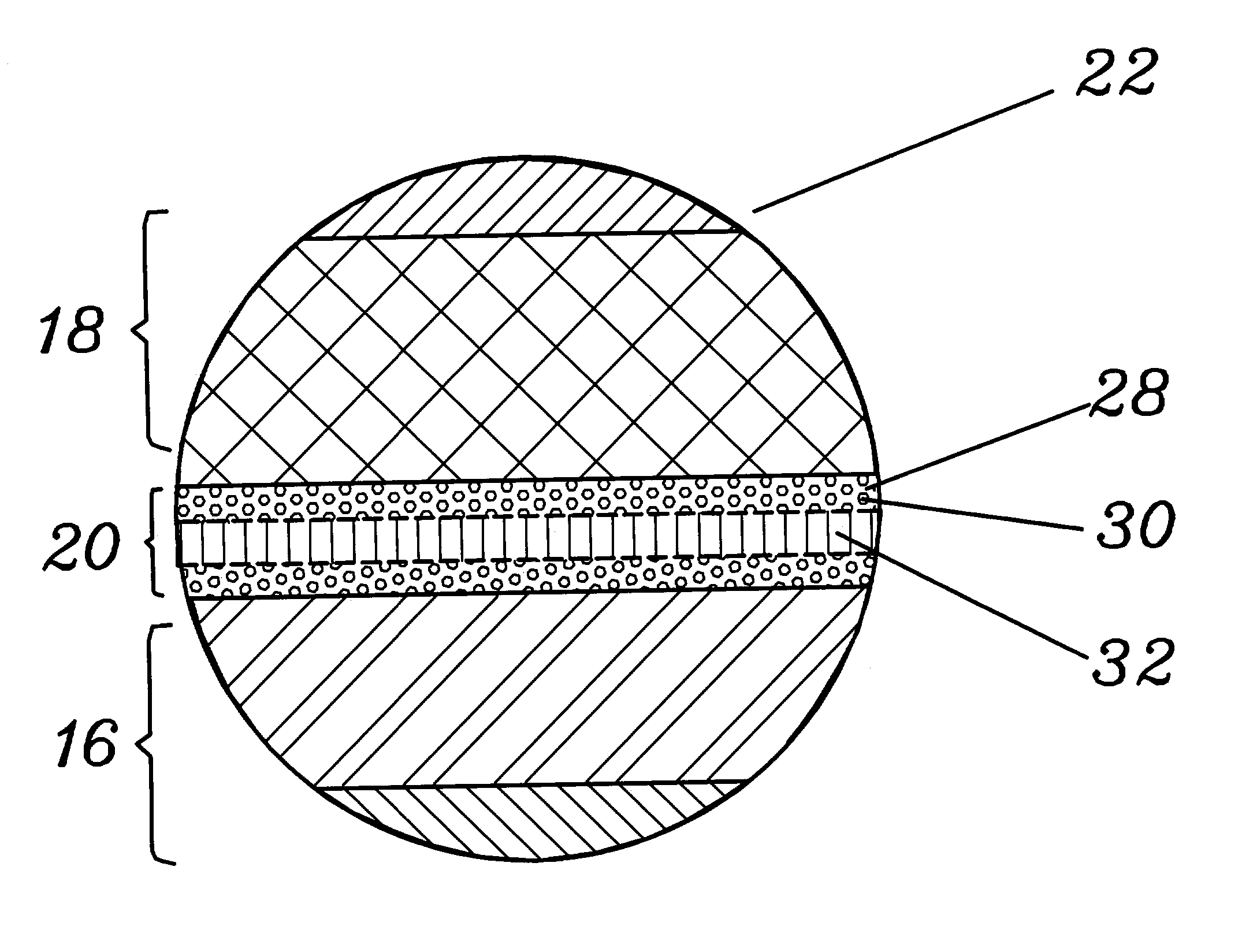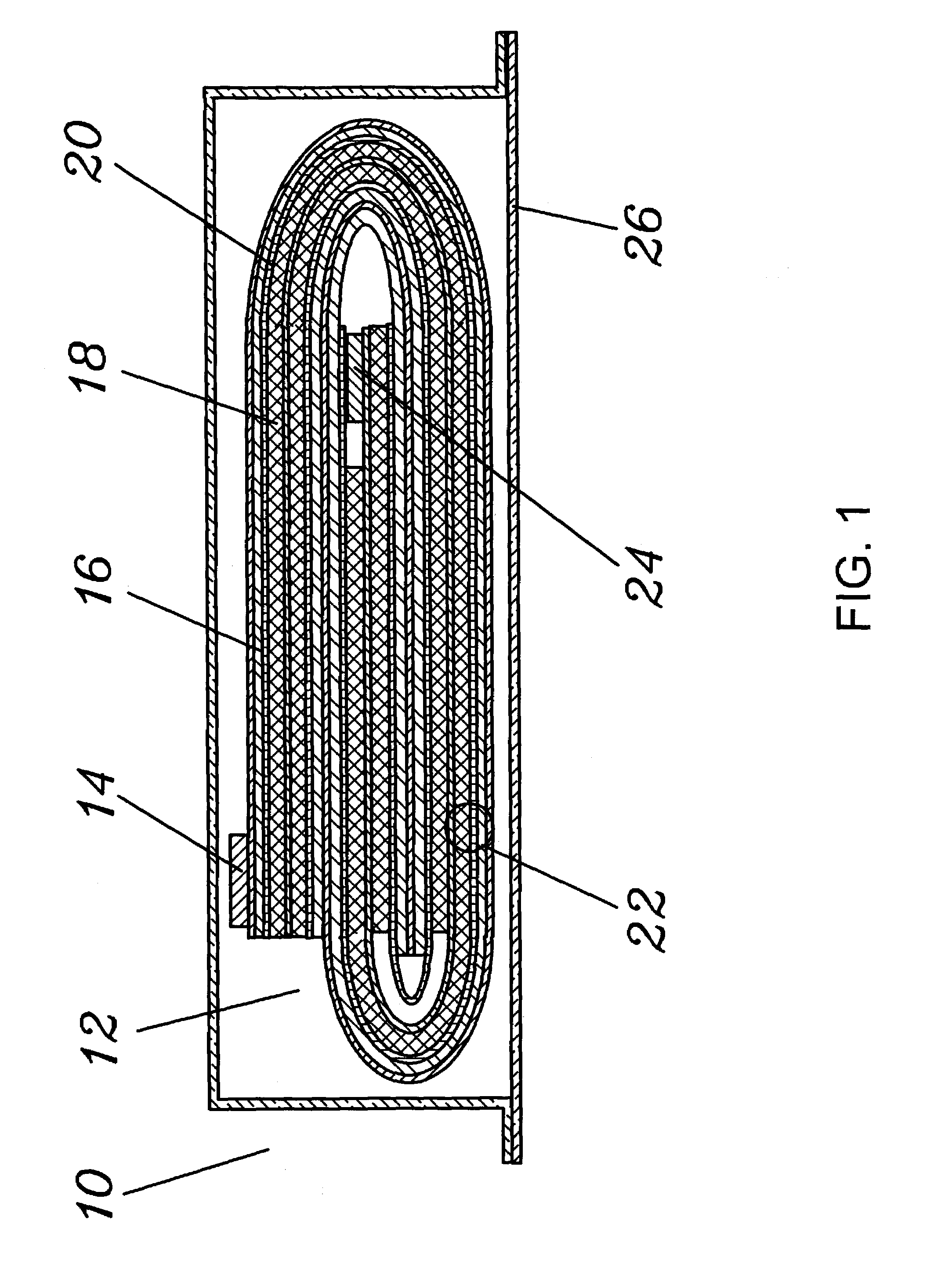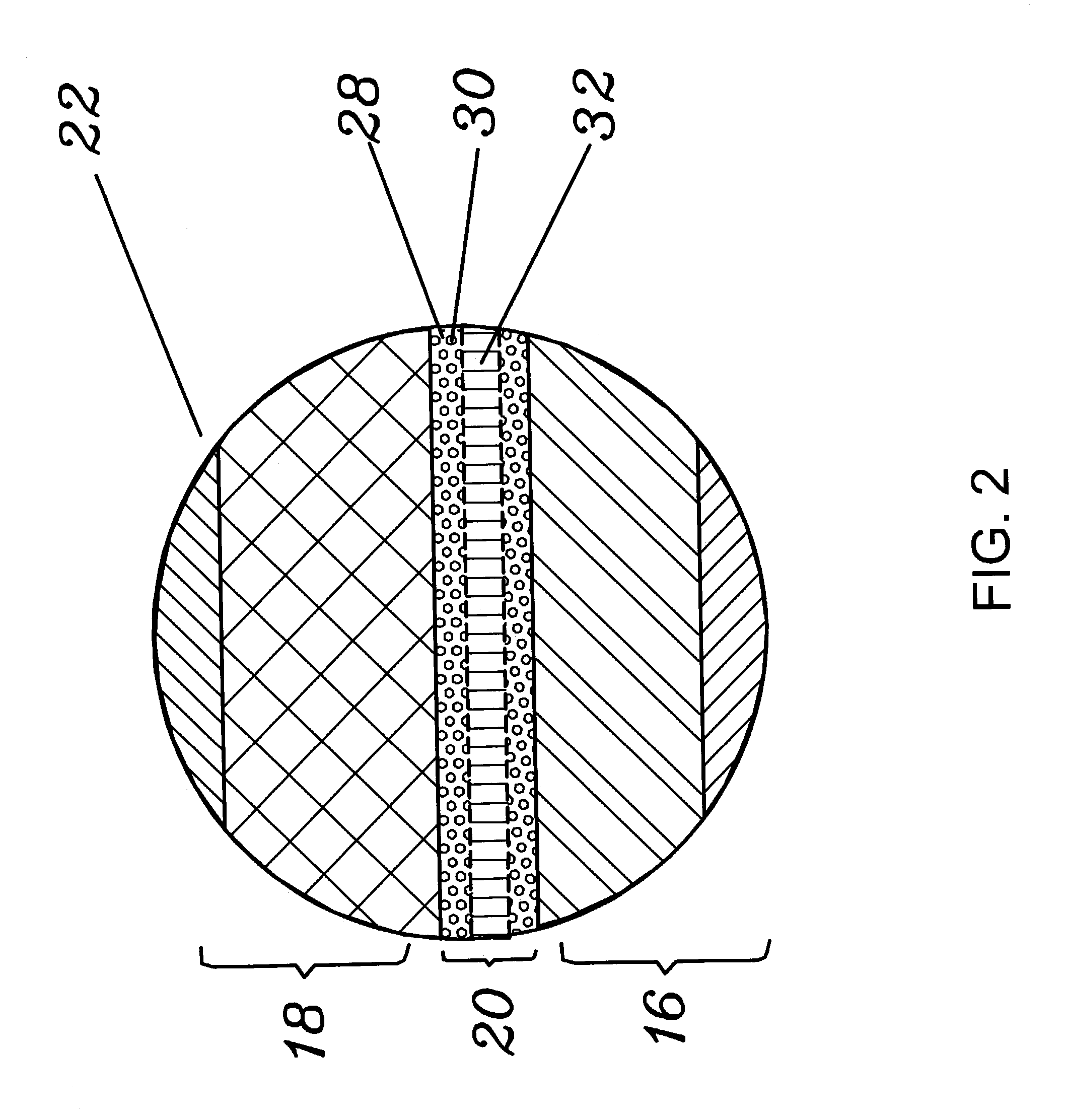Polymer-gel lithium ion battery
a lithium ion battery and polymer gel technology, applied in the field of polymergel lithium ion batteries, can solve the problems of high internal impedance, low efficiency, and low efficiency of polymer lithium ion batteries, and achieve excellent adhesion, high quality, and consistent performan
- Summary
- Abstract
- Description
- Claims
- Application Information
AI Technical Summary
Benefits of technology
Problems solved by technology
Method used
Image
Examples
example 1
[0045]A 100 mAh jellyroll cell was built by folding electrodes / separators three times, as shown in FIG. 1. Compositions of the anode, cathode, separator, P-fluid and E-solution are given below.[0046]Anode: 89% graphite (MPG form Mitsubishi Chemicals), 11% PVDF (Kynar 2801 from Elf-Atochem). Current collector is Cu foil (20 μm thickness). Loading is 12 mg / cm2.[0047]Cathode: 88% LiNi0.8Co0.17Al0.03O2 (CA2003 from Fuji Chemical), 5% carbon black (Super S from MMM), 7% PVDF (Kynar 2801 from Elf-Atochem). Current collector is Al foil (30 μm thickness). Loading is 21 mg / cm2.[0048]Separator: polyolefin microporous membrane (Celgard 2300 from Celgard USA).[0049]P-fluid: 3.5% PVDF (Kynar 2801 from Elf-Atochem) in acetone / PC (20:80).[0050]E-solution: 1.2M LiPF6 in EC / DEC / DMC (25:45:30).[0051]Package bag: Soft Packaging Film from Sumitomo Electric Industries.
[0052]Active materials of the anode and cathode were mixed separately with n-methyl-2-pyrrolidone (NMP) and coated onto the Cu and Al foi...
example 2
[0054]An 80 mAh stacked cell was built by laminating electrodes / separators together as shown in FIG. 3. Compositions of the anode, cathode, separator, P-fluid and E-solution are given below.[0055]Anode: 90% graphite (GDA01 from Mitsui Mining Material Company), 10% PVDF (Kynar 2801 from Elf-Atochem). Current collector is Cu foil (20 μm thickness). Loading is 15 mg / cm2.[0056]Cathode: 88% LiαNiβCo67 MnγO2 (R&D sample), 5% carbon black (Super S from MMM), 7% PVDF (Kynar 2801 from Elf-Atochem). Current collector is Al foil (30 μm thickness). Loading is 27 mg / cm2.[0057]Separator: polyolefin microporous membrane (Celgard 2500 from Celgard USA).[0058]P-fluid: 2.8% PVDF (Kynar 2801 from Elf-Atochem) in MEK / PC (30:70).[0059]E-solution: 1.2M LiPF6 in EC / EMC / DMC (30:50:20).[0060]Package bag: Soft Packaging Film from Sumitomo Electric Industries.
[0061]Active materials of the anode and cathode were mixed separately with n-methyl-2-pyrrolidone (NMP) and coated onto the Cu and Al foils, respectivel...
example 3
[0063]A 100 mAh stacked cell was built by laminating electrodes / separators together. Compositions of the anode, cathode, separator, P-fluid and E-solution are given below.[0064]Anode: 90% graphite (SLA1020 from Superior Graphite Co.), 10% PVDF (Kynar 2801 from Elf-Atochem). Current collector is Cu foil (20 μm thickness). Loading is 13 mg / cm2.[0065]Cathode: 88% LiCoO2 (from FMC USA), 5% carbon black (Super S from MMM), 7% PVDF (Kynar 2801 from Elf-Atochem). Current collector is Al foil (30 μm thickness). Loading is 29 mg / cm2.[0066]Separator: polyolefin microporous membrane (Celgard 2500 from Celgard USA).[0067]P-fluid: 10% PVDF (Kynar 2801 from Elf-Atochem) and 4% DBP (from Aldrich) in acetone / PC (50:50).[0068]E-solution: 1.2M LiPF6 in EC / EMC / DEC (30:45:25).[0069]Package bag: Soft Packaging Film from Sumitomo Electric Industries.
[0070]Active materials of the anode and cathode were mixed separately with n-methyl-2-pyrrolidone (NMP) and coated onto the Cu and Al foils, respectively, by...
PUM
| Property | Measurement | Unit |
|---|---|---|
| Temperature | aaaaa | aaaaa |
| Temperature | aaaaa | aaaaa |
| Fraction | aaaaa | aaaaa |
Abstract
Description
Claims
Application Information
 Login to View More
Login to View More - R&D
- Intellectual Property
- Life Sciences
- Materials
- Tech Scout
- Unparalleled Data Quality
- Higher Quality Content
- 60% Fewer Hallucinations
Browse by: Latest US Patents, China's latest patents, Technical Efficacy Thesaurus, Application Domain, Technology Topic, Popular Technical Reports.
© 2025 PatSnap. All rights reserved.Legal|Privacy policy|Modern Slavery Act Transparency Statement|Sitemap|About US| Contact US: help@patsnap.com



